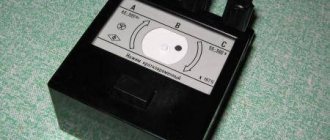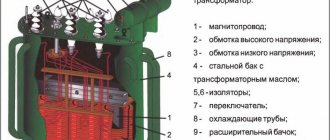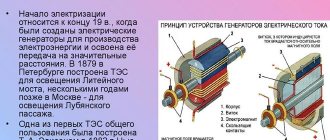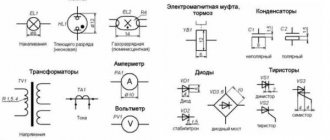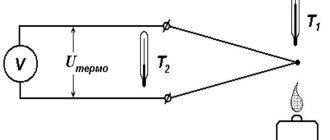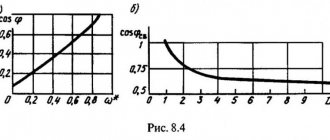Operating principle of an electronic trigger.
The word trigger (trigger) in English means trigger. The function of a trigger is to instantly switch from one stable state to another, under the influence of an external, control factor. There are pneumatic, mechanical and relay trigger circuits. But electronic circuits, in terms of reliability and, most importantly, speed, are certainly unrivaled. The electronic trigger circuit consists of two amplification stages and, in essence, is a type of multivibrator.
The output of each stage is connected to the input of the other, but not through capacitors, as in a conventional symmetrical multivibrator, but through resistors. The values of these resistors are selected so that a cascade with a fully open transistor reliably turns off the transistor of another cascade. If you apply supply voltage to the trigger, then both cascades begin to “fight” with each other, trying to close each other.
No matter how similar the transistors are in terms of characteristics, one of them (let’s assign number 1 to it) will definitely turn out to be “stronger” and will close the other (for convenience, let’s designate it as number 2) Everything happens very quickly, it looks like transistor 1 instantly turns on, and the other (2) closed. The trigger can remain in this state for a very long time. We can call it the 1st stable state.
If you apply a voltage pulse to the input of a closed cascade (2) sufficient to open it for a short time, then when it opens it will “inhibit” cascade 1, which has been in the open state until that moment. Having closed, cascade 1 ceases to lock cascade 2, and it will remain open. Thus, the cascades will change places, the trigger will be in the 2nd stable state.
It can remain in this state for a very long time if an opening pulse is not applied to closed cascade 1. Cascade 1 opens, cascade 2 is inhibited and the trigger returns to its original state (1). It turns out that our trigger has two stable states and two control inputs, by applying pulses of sufficient amplitude to which these states can be changed.
Brief theoretical information
Triggers are designed to store binary information. The use of triggers makes it possible to implement RAM devices (that is, memory in which information is stored only for the duration of calculations).
However, flip-flops can also be used to build some digital memory devices, such as counters, serial-to-parallel converters, or digital delay lines.
RS trigger
The main trigger on which all other triggers are based is the RS trigger. The RS trigger has two logical inputs:
- R – setting 0 (from the word reset);
- S – setting 1 (from the word set).
The RS trigger has two outputs:
- Q – straight;
- Q - reverse (inverse).
The state of the trigger is determined by the state of the direct output. The simplest RS flip-flop consists of two logic elements covered by cross positive feedback.
Let's look at how the trigger works:
Let R=0, S=1. The lower logical element performs the logical OR-NOT function, i.e. 1 at any of its inputs leads to the fact that its output will have a logical zero Q=0. The output Q will be 1 (Q=1), because zeros are supplied to both inputs of the upper element (one zero from input R, the other from output). The trigger is in a single state. If we now remove the setting signal (R=0, S=0), the situation at the output will not change, because Although the lower input of the lower logic gate will receive a 0, its upper input will receive a 1 from the output of the upper logic gate.
It will be interesting➡ How a half-wave rectifier works and where it is used
The flip-flop will remain in the single state until a reset signal is received at the R input. Let now R=1, S=0. Then Q=0, a =1. The trigger switched to “0”. If after this you remove the reset signal (R=0, S=0), then the trigger will still not change its state. To describe the operation of a trigger, a table of states (transitions) is used. Let's denote:
- Q(t) – state of the trigger before the arrival of control signals (changes at inputs R and S);
- Q(t+1) – trigger state after changes at inputs R and S.
Transition table of RS flip-flop in NOR basis
| R | S | Q(t) | Q(t+1) | Explanations |
| Information storage mode R=S=0 | ||||
| 1 | 1 | |||
| 1 | 1 | Unit setting mode S=1 | ||
| 1 | 1 | 1 | ||
| 1 | Zero setting mode R=1 | |||
| 1 | 1 | |||
| 1 | 1 | * | R=S=1 prohibited combination | |
| 1 | 1 | 1 | * |
An RS trigger can also be built using “AND-NOT” elements (Figure 2.2).
Inputs R and S are inverse (active level “0”). The transition (switching) of this trigger from one state to another occurs when one of the inputs is set to “0”. The combination R=S=0 is prohibited.
Transition table of RS flip-flop in the “2AND-NOT” basis
| R | S | Q(t) | Q(t+1) | Explanations |
| * | R=S=0 prohibited combination | |||
| 1 | * | |||
| 1 | Zero setting mode R=0 | |||
| 1 | 1 | |||
| 1 | 1 | Unit setting mode S=0 | ||
| 1 | 1 | 1 | ||
| 1 | 1 | Information storage mode R=S=1 | ||
| 1 | 1 | 1 | 1 |
Synchronous RS trigger
The RS flip-flop circuit allows you to remember the state of the logic circuit, but since a transient process may occur when the input signals change (in digital circuits this process is called “dangerous races”), you need to remember the states of the logic circuit only at certain moments in time, when all transient processes are completed, and the signal at the output of the combinational circuit corresponds to the function it performs. This means that most digital circuits require a synchronization signal (clock signal).
All transient processes in a combinational logic circuit must end during the period of the clock signal supplied to the inputs of the flip-flops. Flip-flops that remember input signals only at the time specified by the synchronization signal are called synchronous. A schematic diagram of a synchronous RS flip-flop is shown.
Transition table of synchronous RS flip-flop
| R | S | C | Q(t) | Q(t+1) | Explanations |
| 1 | Information storage mode R = S = 0 | ||||
| 1 | 1 | 1 | |||
| 1 | 1 | 1 | Unit setting mode S =1 | ||
| 1 | 1 | 1 | 1 | ||
| 1 | 1 | Zero setting mode R=1 | |||
| 1 | 1 | 1 | |||
| 1 | 1 | 1 | * | R = S = 1 prohibited combination | |
| 1 | 1 | 1 | 1 | * |
In table 2.3. By signal C we mean a sync pulse. Without a clock pulse, a synchronous RS flip-flop retains its state.
D - triggers.
To use triggers in real counting devices, it is necessary to be able to additionally control their states - presetting, resetting, activation using a counting clock pulse. To carry out this operation, three more inputs are added to the counting trigger circuit. PRESET(PR) - restores state 1 at the trigger output, and CLEAR(CL) - state 0. Using the clock input T, the trigger is generally synchronized relative to other elements of the counting device circuit. A pulse arriving at the counting input D changes the state of the trigger only if there is a 1 at the clock input.
Universal trigger (JK trigger)
Such a trigger has information inputs J and K, which in their influence are similar to the inputs S and R of a clocked RS trigger:
- when J=1, K=0, the clock pulse trigger is set to state Q=1;
- when J= 0, K=1 – switches to state Q=0;
- when J=K=0 – stores previously received information.
But unlike a synchronous RS flip-flop, the simultaneous presence of logical 1s at the information inputs is not a prohibited combination for a JK flip-flop and leads the flip-flop to the opposite state.
JK flip-flop transition table
| K | J | C | Q(t) | Q(t+1) |
| 1 | ||||
| 1 | 1 | 1 | ||
| 1 | 1 | 1 | ||
| 1 | 1 | 1 | 1 | |
| 1 | 1 | |||
| 1 | 1 | 1 | ||
| 1 | 1 | 1 | 1 | |
| 1 | 1 | 1 | 1 |
Digital electronics – YB-triggers with dominant Y-input
The presence of forbidden combinations for clocked &Y flip-flops gave rise to the idea of building a trigger that forcibly sets Qx to 0 at S = 1 and R = 1 when a clock pulse is applied. This becomes possible thanks to a special connection of the inputs. In Fig. Figure 7.35 shows such a connection of inputs. When S = 1 and R = 1, the 1-signal cannot affect the flip-flop, since the output of the element is NOT 0. The AND-element is locked. 1-signal on R allows reset. The setting mode with S = 1 and R = 0 remains possible, since now the output of the NOT element is 1 and the AND element has a 1 at the output.
Interesting article: What is a solid state relay?
Such a trigger is called an .RS'-trigger with a dominant /?-input, or a ^trigger. The rule of its operation follows from the symbol in Fig. 7.36 (see also section 7.1). It says: if both inputs of the trigger S, R and input T have level 1, then with a synchronization signal 1 Q{ is set to 0, and Q2 is set to 1. The truth table of a clocked LU flip-flop with a dominant R-input is shown in Fig. 7.37. Of course, there is also a clocked RS flip-flop with a dominant ^-input (see reference test).
It will be interesting➡ Direct current - definition and parameters
Logic gates (logical elements).
The processes necessary for the functioning of any technological devices (including PCs) can be implemented using a limited set of logical elements.
Buffer.
A buffer is a current amplifier that serves to match various logic gates, especially those based on different element bases (TL or CMOS).
Inverter.
An element used to invert incoming signals - a logical one turns into zero, and vice versa.
Logic diagram I.
And is an element of logical multiplication. A one (high voltage level) at the output appears only if there are ones present at both inputs at the same time.
An example of using the AND element in a real technical device: According to technical. According to the task, the mechanical press should operate only when two buttons separated by a certain distance are pressed simultaneously. The meaning of those The task is to ensure that both hands of the operator are occupied while the press is moving, which would eliminate the possibility of accidental injury to a limb. This can be implemented just using the AND gate.
Logic circuit AND - NOT.
NAND is the most commonly used element. It consists of AND and NOT logic gates connected in series.
OR logic circuit.
OR is a logical addition circuit. A logical one at the output appears if a high level (one) is present at any of the inputs.
Logic circuit OR - NOT.
OR - NOT consists of logical elements OR and NOT connected in series. Accordingly, it does NOT invert the values at the OR output.
Exclusive OR logic circuit.
This gate produces a logical one at the output if one of the inputs is one and the other is zero. If the inputs have the same values, the output is zero.
What are triggers - briefly
The term trigger comes from the English word trigger - latch, trigger. To denote this scheme in English, the term flip-flop is more often used, which means “flapping”. This onomatopoeic name for an electronic circuit refers to its ability to almost instantly transition (“switch”) from one electrical state to another and vice versa.
The most common type of trigger is the so-called RS trigger (S and R, respectively, from the English set - installation, and reset - reset). The trigger symbol is shown in Fig. 5.6.
It has two symmetrical inputs S and R and two symmetrical outputs Q and , with the output signal Q being the logical negation of the signal . Each of the two inputs S and R can receive input signals in the form of short-term pulses ( ). The presence of a pulse at the input will be considered one, and its absence - zero. In Fig. Figure 5.7 shows an implementation of a flip-flop using NOR gates and the corresponding truth table.
| S | R | Q | |
| forbidden | |||
| 1 | 1 | ||
| 1 | 1 | ||
| 1 | 1 | bit storage | |
Let's analyze possible combinations of values of the inputs R and S of the flip-flop using its circuit and the truth table of the OR-NOT circuit (Table 5.5).
- If S=”1″, R=”0″ is applied to the trigger inputs, then (regardless of the state) “0” will appear at the Q output of the upper gate. After this, the inputs of the lower gate will have R=”0″, Q=”0″ and the output will become equal to “1”.
- In the same way, when “0” is applied to the S input and “1” to the R input, “0” will appear at the output, and “1” will appear at Q.
- If a logical “1” is applied to the R and S inputs, then the Q state does not change.
- Applying a logic “0” to both inputs R and S can lead to ambiguous results, so this combination of input signals is prohibited.
Since one trigger can remember only one digit of binary code, 8 flip-flops are needed to remember a byte, and 8 x 210 = 8192 flip-flops are needed to remember a kilobyte, respectively. Modern memory chips contain millions of triggers.
Trigger classification
Trigger systems differ from each other in terms of functionality, type of control, number of possible states and levels, method of responding to interference, composition of basic logical elements and other features. However, all of them, from the simplest circuits to complex multi-stage structures with multiple states, work on the same principle.
You may be interested in this Characteristics and connection diagram of the SO-505 electric meter
General Differences
Triggers are divided into several large groups based on functional and practical differences. Here are some of them:
- According to the control principle, they are static (or potential) and dynamic. The first respond to the direct supply of input signals corresponding to one or zero. The latter perceive a change in signal from one to another.
- Static ones, in turn, are divided into two groups: symmetrical and asymmetrical. They differ in the internal structure of the electrical connections in the circuit - for symmetrical ones they are identical in all individual cells of the device. They make up the bulk of triggers.
- According to functional features. The most common type of such classification is synchronous and asynchronous. The former come into action only when the rate changes from zero to one or vice versa, while the latter perceive the immediate moment the signal appears.
- According to the number of steps and levels.
- Based on their response to interference, triggers can be divided into transparent and opaque, which, in turn, are permeable and impenetrable.
- In accordance with the number of possible stable states. Most often there are two of them, but there are also ternary, quaternary and other elements.
- According to the logical composition, quantity and ratio of AND-NOT and OR-NOT elements.
- With complex and simple logic.
All trigger classification systems interact and complement each other. For example, a two-stage flip-flop can be synchronous or asynchronous, have static or dynamic control, and so on. Separate types of these systems with different names are also identified.
Device types
Speaking about the differences between triggers, it is worth considering their individual types. The simplest of them is the RS trigger, on the basis of which all other types of these devices are built, so this is where you should start getting acquainted “for dummies.” This is an asynchronous type of system, which consists of two inputs - S (from the English set - set) and R (respectively, reset - reset). It can work both on the basis of logical systems AND-NOT and OR-NOT. In the first case, the inputs will be direct, in the second - inverse.
You might be interested in The work of third-party forces in a DC circuit and sources of EMF
Applying an active signal to element S will bring the PC trigger to a logical one state, and to R it will reset it to zero. If they are applied simultaneously, the result depends on the implementation of the scheme, and when removed, it will be determined randomly.
Due to low immunity to interference, this type of device is rarely used in electronics and microcircuits. Most often it is used to eliminate the so-called bounce of contacts - multiple chaotic short circuits and openings caused by the elasticity of the materials used for them and occurring after they are connected.
The RS type system is asynchronous. If there is a need to save the information received on it, a separately designed control system is connected to the device, which will switch it into storage and recording modes.
The second type is the D trigger (according to some sources, the name comes from the English word delay - delay, according to others - from data). It must contain at least two elements: a D input for receiving information and a C input for synchronization. Such systems can be static or dynamic. The former record data all the time when the signal level at C corresponds to unity, the latter only when a voltage drop occurs.
The input on the D flip-flop circuit is depicted as a triangle. When its top is directed to the microcircuit, then its input is direct, and if vice versa, it is inverse.
The information at the outputs in this type of system is delayed compared to the input by one clock cycle. Since it remains unchanged until the next synchronization command is activated, the device seems to remember it, which allows it to perform its main functions. The main one is the creation of shift and storage registers to control the recording of information. These are very important elements, without which it is impossible to create even the simplest microprocessor.
Due to the fact that all changes at the input D of the system are exactly repeated at its output, false alarms of the devices controlled by it are sometimes possible. To avoid this, you need to create a two-stage trigger. Its first stage records information, but it does not reach the second stage until the rewrite signal arrives. Then, after receiving the command, the first stage goes into storage mode, and the second rewrites the data from it, which helps to avoid the state of “transparency”.
Two-stage triggers are designated TT. They can be controlled either statically or dynamically.
T trigger (from the word “toggle”, which means “switch”) is also called a counter trigger, since it is the simplest version of a counter of up to two. Consists of an input T and an output C. Synchronous systems of this type switch at each clock pulse on the output, while the operation of an asynchronous system depends on the state of the input. When it corresponds to one, upon receiving a pulse at the output, the trigger changes its value to the opposite, and if it is equal to zero, then no reaction occurs.
You may be interested in this: Connecting a pass-through light switch according to the diagram
Such an asynchronous system can be built on the basis of a JK or a two-step D flip-flop. It is mainly used to divide the frequency by half.
The last of the most commonly used types is the JK trigger. It operates almost identically to the RS. Its only difference is that a JK type system changes its state to the opposite when one is applied to both inputs. This helps to avoid the uncertainties that sometimes arise.
JK is sometimes called a universal trigger. There are two reasons for this. The first is the wide range of applications of such elements. The second is the fact that you can easily get any other type of system from it if needed for some reason.


